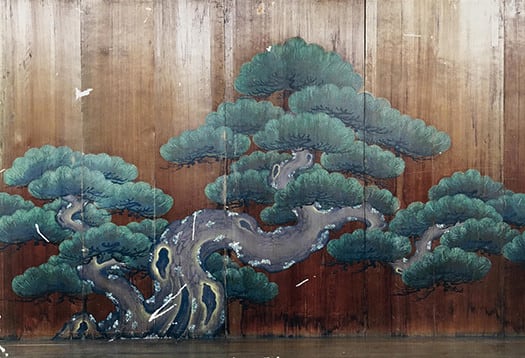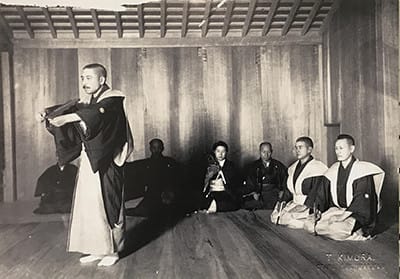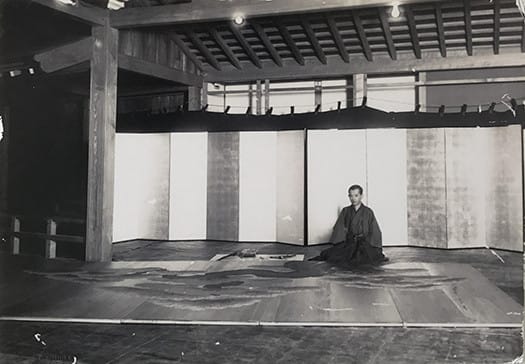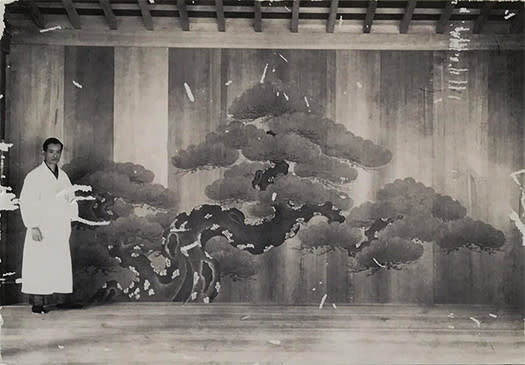



能舞台の背景を印象強く彩る「鏡板」。
日本の建築文化の「粋」とも思えるこの建築装置に対して、
小樽の経済的成功者一族は、故郷の佐渡「神代杉」をはるばる「勧請」した。
用材に対して「勧請」というのは変な用語だと思うけれど、
その労役の巨大さを思えば、あえてそう呼びたい。
2枚目の写真は能舞台が建築として完成したときに
当主の岡崎氏が能を舞った様子だとされていた。
よく見ると、1枚目の鏡板の松の絵柄が表装されていない。
この松の絵柄はなんと当時の「狩野派」当主が小樽に招かれて
2ヶ月掛けて描き上げたものなのだというのです。
〜1925年7月には建築工事に着手、1926年1月26日に舞台開きを迎え、
1927年11月には狩野派第17代の狩野秉信(かのうもちのぶ)が
延べ2か月滞在して描いた鏡板の絵が完成した。〜
2枚目の写真は1926年初頭の「舞台開き」のときの記念写真。
そして3−4枚目は1927年11月当時の絵画制作過程。
おお、であります。
揮毫というコトバは「文字を書く」行為にのみ使われると思っていたら、
こういう絵を描くことも揮毫だということを初めて知った。
ちょうど「鎌倉殿の13人」で奈良大仏殿復興に際して後白河帝が揮毫した様子が
ドラマとして放映されていましたが、権威を持った存在の書画行為という意味。
日本史の中で折に触れて「狩野派」という存在は日本絵画の宗家として
ときどき彩ってくるけれど、リアリティを持って周辺状況を知ることはあまりない。
まことに中世社会での堺の町のように、小樽ではごく最近100年程度の
直近の歴史事実としてこういう状況があったのですね。
「狩野派宗家」に揮毫を依頼することの意味合いが伝わってくる。
狩野派は織田信長が築城した安土城の装飾絵画を受注した。
「天下」意識の異常に昂進した信長の時代、
日本絵画文化の正嫡を自認した狩野派はそのように歴史を彩った。
そういう日本史の空気感が20世紀の北海道でも発露していた。
日本社会の伝統、底流を形成する文化性は
北海道という新開地だからこそ、目に見えるかたちで表出したのでしょう。
日本文化がこの北海道という大地に刻印される生々しい現場と思える。
開拓初期において「北海道開拓使」という存在は中央省庁だった。
そして開拓が一段落した機会に最新文明の象徴である鉄道が関西地区よりも前に
小樽〜札幌間に敷設され、明治帝がはじめて乗車されて札幌に光臨される。
あらたに開拓された領土に対して「日本化」させる民族の努力が
文化領域で痕跡として残された、そういった証拠のような気がしますね。
English version⬇
Noh Stage in Otaru, Hokkaido, where Japanese cultural history is concentrated.
The Kano school's head priest wrote calligraphy on the mirror plate of the Noh stage. It can be seen as an imprint of Japanese culture on the newly developed land of the north. The Noh stage is a comprehensive Japanese art form. Noh Stage
Kagami-ita," or mirror plate, is an impressive backdrop for the Noh stage.
The family of a financially successful Otaru family, who had purchased the "kagami-ita" cedar from their hometown in Sado, Japan, for this architectural device, which can be considered the "essence" of Japanese architectural culture.
The family of a financially successful man from Otaru had to "requisition" their hometown of "Jindai cedars" from Sado Island.
Although "kanboku" may seem an odd term for a material, it is a very important one.
However, considering the enormity of the labor involved, I dare to call it so.
The second photo shows the Noh stage when it was completed as a building.
The second photo is said to show Mr. Okazaki, the head of the family, performing Noh when the Noh stage was completed as an architectural structure.
If you look closely, you can see that the pine tree on the first picture is not covered.
The pine tree was painted by the head of the "Kano school" of the time, who was invited to Otaru and spent two months painting it.
It took two months to complete the painting.
〜Construction work began in July 1925, and the stage was opened on January 26, 1926.
In November 1927, Mochinobu Kano, the 17th head of the Kano school, stayed for two months to paint the mirror.
In November 1927, the painting of the mirror panel was completed, which Kano Mochinobu, the 17th generation of the Kano school, painted during his two-month stay in Japan. ~ The second photo was taken in early 1926.
The second photo is a commemorative photo taken at the "stage opening" in early 1926.
The third and fourth pictures show the painting process in November 1927.
Oh, yes.
I had thought that the word "gaiyō" was used only for the act of "writing.
I learned for the first time that drawing pictures like this is also called "gaiyo" (painting).
In the drama "Kamakura-dono no 13inin", the scene where Emperor Goshirakawa painted on the occasion of the reconstruction of the Great Buddha Hall in Nara was broadcasted.
It means an act of writing or painting by a person with authority.
In Japanese history, the "Kano school" is sometimes mentioned as the head family of Japanese painting.
However, we do not know much about the surrounding circumstances with a sense of reality.
It is true that, like the town of Sakai in the medieval society, Otaru had a situation like this as a recent historical fact in the last 100 years or so.
So, there was this kind of situation in Otaru as a recent historical fact.
The significance of asking the "Soke of the Kano School" to write the script comes through.
The Kano school received orders for decorative paintings for Azuchi Castle, which was built by Oda Nobunaga.
In the era of Nobunaga, who was unusually ambitious in his "descent from heaven" mindset, the Kano school was the legitimate owner of the Japanese painting culture.
The Kano school, which was recognized as the legitimate leader of Japanese painting culture, colored history in this way.
This atmosphere of Japanese history was also emanating in Hokkaido in the 20th century.
The traditions of Japanese society and the cultural nature that forms the undercurrent of Japanese society are
The traditions of Japanese society and the culture that formed the foundation of Japanese society were made visible only in Hokkaido, a newly developed region.
It seems to be a vivid site where Japanese culture was imprinted on the land of Hokkaido.
In the early days of pioneering, the "Hokkaido Kaitakushi" was the central government ministry.
And when the pioneering work was completed, the railroad, a symbol of the latest civilization, was built between Otaru and Sapporo before the Kansai region.
The Emperor Meiji took a train for the first time and came to Sapporo.
The efforts of the people to "Japanize" the newly developed territory
The Japanese people's efforts to "Japanize" the newly settled territory left traces in the cultural realm.










